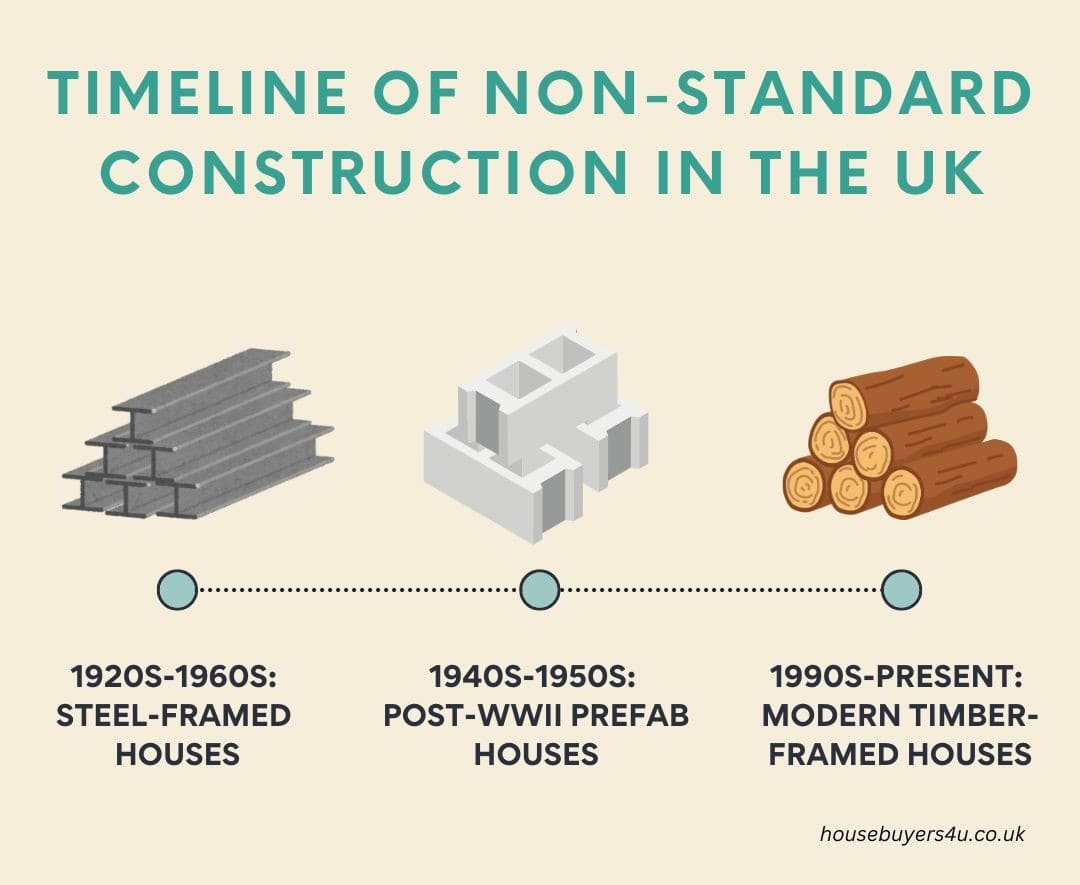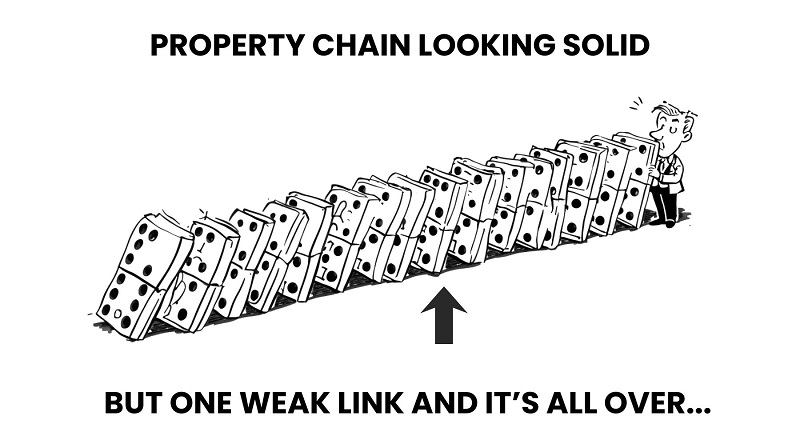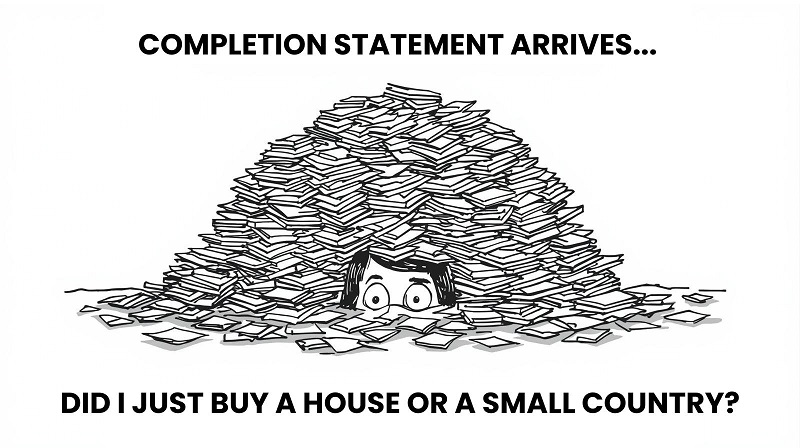Selling your Non-Standard Construction House: Expert Tips

Updated: June 2025
Thinking about selling your non-standard construction house? You’re not alone plenty of homeowners find that selling a property built with anything other than brick or stone comes with extra challenges. Whether your place has concrete walls, a timber frame, or something a bit unusual, it can feel like you’re fighting an uphill battle. The good news? It’s possible to sell quickly and smoothly with the right approach.
Here’s what you need to know & how we can help:
- The key differences between standard and non-standard homes
- Mortgage approvals for non-standard properties can be tricky, potentially limiting your buyer pool.
- How cash buyers are useful because they don’t need mortgage approvals.
What is Non-Standard Construction?
Non-standard construction describes any house that isn’t built with the usual brick or stone walls and tile or slate roof. If your home uses materials like concrete, timber, steel, glass, or even asbestos, it’s considered non-standard. These types of properties are common across the UK—think prefab concrete houses, steel-framed homes, or timber frames and while they can be perfectly solid, they often need specialist lenders or buyers because mortgages and insurance are trickier to get than with standard homes.
How to Identify Non-Standard Construction
Identifying whether your home is non-standard can feel a bit overwhelming at first, but it’s actually simpler than you might think. So, how can you tell if your house falls into this category?
Key Differences Between Standard vs Non-Standard Construction
| Aspect | Standard Construction | Non-Standard Construction |
|---|---|---|
| Materials | Brick or stone walls, tile or slate roof | Concrete, metal, wood, glass, etc. |
| Mortgage Availability | Widely available | Limited, often requires specialist lenders |
| Insurance Costs | Standard rates | Often higher |
| Resale Value | Generally stable | Can be more volatile |
| Buyer Pool | Large | More limited |
| Selling Process | Usually straightforward | Can be more complex |
Common Non-Standard Wall Materials
First, take a look at the walls. Is your home built with something other than brick or stone? Non-standard walls can be made from a variety of materials, such as:
-
Concrete
-
Metal
-
Corrugated iron
-
Wood
-
Glass
-
Flint
-
Asbestos
-
Wattle and daub
If you spot any of these or if your walls don’t fit the typical brick-and-mortar style, then your house is likely considered non-standard construction.
Non-Standard Roof Materials
Next, let’s move to the roof. What’s it made of? A traditional roof would use tile or slate.
Non-standard roof materials include the following:
-
Thatches
-
Fibreglass
-
Corrugated iron
-
Asphalt
-
Steel
-
Concrete
-
Plastic
-
Glass
-
Asbestos
-
Felt and timber
-
Shingles
-
Stramit board (straw board)
These materials are less common in modern construction, but you might find them in older properties or homes with a more unique design.
Advice from our Property Expert Paul:It’s perfectly normal for you to be unsure about what materials were used in your home’s construction—it’s not always obvious, and I completely understand that. From my perspective, the best thing to do in situations like this is to consult a surveyor or another expert. They can confirm exactly what materials were used and help you understand how this might impact the sale of your home.
Trust me, a quick survey can save you a lot of time and give you the clarity you need to move forward with confidence!
Common Types of Non-Standard Construction in the UK
Non-standard construction is more common than you might think, especially in certain types of homes built in the UK. So, what are the most common types of non-standard construction you might come across?
1) Steel-Framed Houses
Another common type of non-standard construction is the steel-framed house. According to The Architect’s Journal, approximately 150,000 steel houses have been built across the UK.
These were popular from the 1920s to the 1960s, particularly because steel was considered strong and durable.
However, over time, the steel can corrode, making these homes trickier to finance or insure. If your home has steel supports instead of traditional wooden framing, it could be non-standard.
Related Read: When was my house built?
2) Post-World War II Prefabricated Concrete Houses
After World War II, the UK faced a housing shortage. The government decided to solve the crisis by building prefabricated concrete homes.
These homes are meant to shelter families temporarily but some homes are still standing until today.
In Birmingham, the city council has restored and preserved 16 historic Phoenix prefabricated houses from World War II. These are now avail for social housing.
Councillor Jayne Francis, cabinet member for housing and homelessness, mentioned:
“The Wake Green Road bungalows are an important part of history that we are proud to preserve. It’s wonderful to have this living bit of history so close to the centre of Birmingham.The restoration programme has brought the bungalows up to modern standards while keeping and reusing as many of the original items in the bungalows as possible. This work is only a small part of the council’s drive to make council homes greener, warmer and more energy efficient.”
3) Timber-Framed Houses
You’ve probably heard of timber-framed houses. These homes use wooden frames for the structure, which isn’t typical in modern UK construction, where brick and stone are more common.
Timber-framed houses have been around for centuries, and while they offer charm and character, they’re also considered non-standard by today’s standards.
Did you know?✕The National House Building Council (NHBC) reports that timber frame construction accounts for approximately 9% of new homes in England, 22% in Wales, 30% in Northern Ireland, and 92% in Scotland.
Although timber-framed houses are considered non-standard construction, the UK government is now considering building more of these to solve the house shortage crisis.
According to Jon Di-Stefano, chief executive of Greencore Homes:
“The timber roadmap is part of thinking about how the process of reducing embodied carbon works. Because if developers keep using bricks and blocks, there’s only so much you can do to reduce your embodied carbon.Timber, when it is being grown, locks up carbon rather than emitting it, therefore from an embodied carbon perspective no matter how you measure it you are immediately in a better position from an environmental perspective.
The government is looking at how timber can be part of the future homes standard."
Why Does This Matter When Selling?
Well, selling a home that is considered non-standard can be tricky. We know how frustrating when most buyers and banks do not prefer your property because it doesn't tick the "traditional" boxes.
Mortgage lenders consider non-standard properties to be higher risk. This can limit potential buyers, especially if they need a mortgage.
Moreover, standard mortgage deposits are typically around 20% of the property’s value. However, for non-standard properties, deposits may start at 25%, and some may even require up to 40%. This huge deposit may also discourage other buyers.
But, don't lose hope! It’s not as complicated as it sounds.
Getting a surveyor’s report to hand can be a great way to be transparent with buyers and answer any questions upfront and with confidence. This can help you build trust and speed up the selling process by addressing concerns early.
How Fast Can You Sell? Our Data on Standard vs Non-Standard Homes
At Housebuyers4u, we’ve helped hundreds of homeowners move on from properties of all shapes and sizes. One thing we see time and again: non-standard homes can take months longer to sell on the open market, usually due to mortgage delays or buyers pulling out last minute. Our cash buying process removes these headaches and cuts down waiting time, often by several months.
Here’s what our own data shows about the difference:
| Property Type | Average Sale Time with HB4U | Average Sale Time (Open Market) | Most Common Sale Challenge |
|---|---|---|---|
| Standard Construction | 14 days | 110 days | Price negotiation |
| Non-Standard | 17 days | 145 days | Mortgage issues, buyer dropouts |
How Housebuyers4u Can Help
Selling a non-standard construction home has its challenges, but that's where we shine. At Housebuyers4u, we buy houses fast for cash and we turn unique sales into smooth, stress-free experiences.
We’re proud to be one of the only house buying company that offers a 100% no fall-through guarantee—no hidden catches, no last-minute surprises.
Whether your home is built from non-traditional materials or has a unique design, we’ll buy it directly with our own funds.
This means no middlemen, no waiting for mortgage approvals, and no complications.
Learn More About How to Sell Your House Fast in the UK
- Best Time of the Year to Sell Your House
- Should I Sell My House to Pay Off Debt?
- Selling Your House After Divorce
- How to Sell an Inherited Property Fast
- Sell House Due to Job Relocation
- Selling your House Due to Health Issues
- Selling a House in Poor Condition
- How to Sell a House with Bad Tenants
- How to Sell your Tenanted Property
- How to Sell My Flat Quickly
- How to Sell Your House to an Investor Fast
- How to Sell your House Online
- Selling Your House Without an Estate Agent in the UK
- How to Sell your Empty House Fast in the UK
- Common Mistakes When Selling Your Home
- How Long Does It Take to Sell a House UK?
- How to Stage a House for Sale
- Sell My House Fast for Market Value UK
- Selling your House Due to Financial Difficulties
- Selling a House in Poor Condition
- What is Gazundering?
- Selling Your House Due to Relocation or Emigration?
Need Help With a Property Stuck in a Property Chain?




